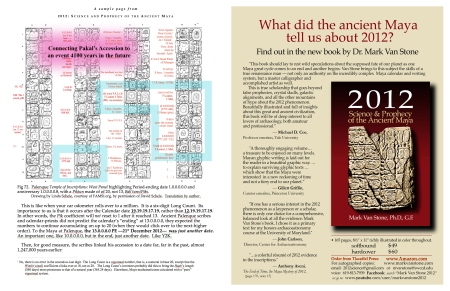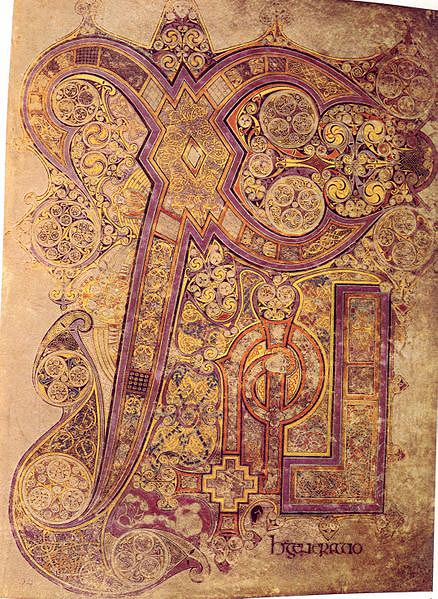Perhaps the most notorious of European soothsayers is the 16th-century French apothecary, Michel de Nostredame, better known by his Latinized name, Nostradamus.
(His surname, like the Paris cathedral, simply means “Our Lady.” His Jewish grandfather converted to Catholicism on Our Lady’s Day, 1455, and, like many a new-born [and ancient Mesoamericans], adopted the name of his “birthday” as his own.)
His famed Prophecies purportedly predicted pivotal and tragic events in Europe and America such as World War II, Princess Diana’s death, and the 9/11 destruction of the World Trade Center Towers (nobody claims they predicted any events in Asia or Africa, as far as I know). Lately they have been applied to 2012.
He composed his prophecies over eleven years for an annual Almanac that he first published in 1550. (This tradition continues, in such publications as the Old Farmer’s Almanac, whose long-range weather predictions are reputed to be better than the US Weather Service’s.) He selected about a thousand of these to re-cast as 4-line rhymed poems (called quatrains), and they were published in many editions. Due to the casual standards of 16th and 17th-century typesetters, no two copies are exactly alike. Most English translations are based on later, increasingly corrupted, copies of copies. Very few versions of his prophecies can be trusted. But the worst of it is, his own obscurantist compositions are impossible to pin down.
This is partly due to Nostradamus’s own paranoia. This was the age of Inquisitional pyres and suppression; he may have deliberately obfuscated his quatrains to keep them “safe”. A perfect Da Vinci Code intellectual! Written mostly in French, the quatrains are vague, full of multiple-entendres, and larded with esoteric references and vocabulary, some of it in Latin, Greek, Italian, and Provençal. They are hideously difficult to translate. A careful, annotated edition of his prophecies would demand commentary ten or twenty times as long as the quatrains themselves. (A glimpse at the voluminous websites of his latter-day interpreters seem to be moving in this direction.)
He himself carefully rejected the title “prophet”. Perhaps he did so simply to maintain his friendly relationship with the Church. Also, note that most of his prophecies were translations into French of older predictions, largely from a popular Latin book of 1522, the Mirabilis Liber. (He lifted 139 of his surviving 942 prophecies from here.) Quoting the fine Wikipedia article “Nostradamus”:
“Nostradamus was one of the first to re-paraphrase these prophecies in French, which may explain why they are credited to him. It should be noted that modern views of plagiarism did not apply in the 16th century. Authors frequently copied and paraphrased passages without acknowledgement, especially from the classics.”
Peter Lemesurier’s excellent Nostradamus website <http://www.nostradamus-repository.org/> contains careful English translations from sources as-original-as-possible, and also includes the original French versions, so you can translate and decide for yourself. Lemesurier also answers a few Nostradmic Myths and Frequently-Asked-Questions.
I recommend particularly his FAQ’s regarding Nostradamus and 9/11. < http://www.nostradamus-repository.org/index.php?option=com_content&view=article&id=32:911-attacks-and-nyc&catid=7:terror-related&Itemid=6 >.
The misunderstandings, mistranslations, Procrustean interpretations, and deliberate fabrications addressed here epitomize what we might term the two “Nostradamus Problems”. These Problems lie chiefly with (1) the source and (2) the recipient.
The first : He was a master Oracle: he couched his “prophecies” in universally-interpretable language, phrased so that one could read anything into them.
The second: Our proclivity for projecting our own fantasies and fears thereon.
Quoting from his 9/11 FAQ’s:
Q. What about “In the year of the new century and nine months, from the sky will come a great king of terror…the sky will burn at 45 degrees. Fire approaches the great new city…In the city of york there will be great collapse, twin brothers. Torn apart by chaos while the fortresses fall, the great leader will succumb; the third big war will come when the big city is burning.”?
A. It’s a garbled mixture of carefully selected lines from two different Nostradamus quatrains (X.72, which in the original doesn’t even mention a ‘King of Terror’ — see third website listed below — and is about *1999* [!!]; and VI.79, whose ‘new city’ on 45 degrees is Villeneuve in SW France, not New York, which is on 40 degrees 40 minutes) plus a bunch of other lines that are not by Nostradamus at all. …
Q. How about: “Earth-shaking fire from the center of the earth. Will cause the towers around the New City to shake, Two great rocks for a long time will make war, And then Arethusa will color a new river red. ”
A. A more reliable (and artistic) translation of I.87 (which doesn’t mention towers at all) would read:
“Earth-shaking fires from the world’s centre roar: About Villeneuve (=“New City”) the earth shall be a-quiver. Two leaders long shall wage a fruitless war, Till Arethusa reddens a new river.”
Line 3 is in fact based on a French expression (‘faire la guerre aux rochers’ — ‘to make war on the rocks’) which in fact means ‘to struggle fruitlessly’. ‘Deux grands‘ means ‘two nobles’.
——- ——– ——-
The First Problem: Nostradamus follows a venerable tradition established by successful Soothsayers, Sibyls and Prophets thousands of years ago. This involves phrasing one’s prophecies ambiguously. The Oracle at Delphi, for example, routinely intoned such gems as this one, delivered to Croesus: “If you attack Persia, a great empire will be destroyed.” A prediction guaranteed to succeed, no matter who won, eh?
Modern newspaper horoscope-writers employ the same stratagems, describing a person’s character, or the prognostication for the day, in terms that are so general as to be likewise guaranteed. “You have good intentions, but tend to procrastinate.” “A day full of opportunity.” “Every dark cloud has a silver lining.”
For a clear demonstration of this, collect the twelve horoscopes from any daily newspaper. Don’t read it. Have a trusted (and tolerant) friend cut the dates off the horoscopes, and secretly make a Key, linking which dates go with which predictions. (To be truly double-blind, the friend must seal the Key in an envelope, hand the slips of paper to a third friend, who has not seen the originals, and that friend should deliver the shorn horoscopes to you.) Then you decide which horoscope applies to you. Then unseal the Key and check your guess. Record your results. No cheating! Do this a few dozen times.
I guarantee, I prophesy, that you will be right 8.333% of the time. More or less. This is because horoscope texts are full of generalized characterizations, adjectives and adverbs that tend to describe everyone. Everyone. You can devise similar ways to test the more complex, more specific —and more expensive— personal horoscopes, delivered by professional astrologers.
The other Problem: we all tend to be narcissists. In art-history classes, I remind my students that we respond most strongly to works of art that are “mirrors”, pictures (usually) in which we recognize some aspect of ourselves. Prophecies are works of art, if nothing else, and we always see ourselves there. Simple as that. We also instinctively seek connections and patterns, and we are such complex, multi-faceted characters that there exist few characterizations that do *not* apply to us.
We usually consider the test of a prophecy to be whether it comes true. I propose a more rigorous test: can it help us make better choices? If Caesar had listened to that guy who told him, “Beware the Ides of March” and stayed home, he might have become Rome’s first Emperor. But he didn’t. They never do. Not believing our prophets is so common as to be a cliché. The Ancient Greeks personify this penchant in the unhearkened prophetess Cassandra. Nostradamus was, at best, a Cassandra. None, I repeat, *None* of Nostradamus’s prophecies have helped *anyone* avert, avoid, or mitigate a disaster. What good is a prophecy that no-one can use beforehand? I assert that a “prophecy” that helps no-one, is no prophecy at all.
This is also true for 2012. Aside from selling us nuke-proof bunkers stocked with water-purifiers and freeze-dried food, the millions of 2012-prophecy websites don’t really offer us any advice on what to *do* about it. How do we surf this wave, instead of drowning in it? Those few who offer it, advise you to Clean Up Your Act, Forgive and Forget, Get Right With God, Set Your Sights On Higher Matters, and Open Yourself To Opportunity. These are good suggestions. So good, I think I’ll not wait till 2012. So good, some people have been living them for years already. We should implement them even if nothing happens in 2012, no?
By the way, has anyone noticed that Nostradamus was born either 14th or 21st December, 1503? If the latter, then the 2012 Period-Ending would fall precisely on his 509th birthday. 509 is a prime number! There is even a parallel in the date-uncertainty, because some scholars fix the Great Maya Period-Ending on 21st December, and others the 23rd! Could all this be a coincidence?
My book, “2012: Science and Prophecy of the Ancient Maya” is almost ready, and will be ready for upload before the end of the year… Stay tuned!

